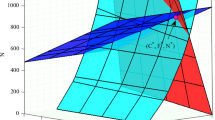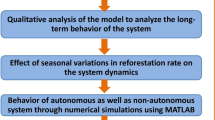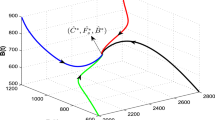Abstract
An increment in carbon dioxide (\(CO _2\)) results in global warming posed a threat to the mankind. Mitigation of anthropogenic \(CO _2\) emission is important for climate change alleviation. In this regard, some significant steps are taken by the government of every country, which requires budget. In this paper, to observe the effect of budget allocation on the abatement of atmospheric concentration of \(CO _2\), a non-linear mathematical model is formulated and analyzed. In the modeling process, it is considered that a part of the available budget is used for the control of anthropogenic emission and the remaining part of budget is used for afforestation and reforestation. For the proposed model, feasibility and stability of all the equilibria have been discussed. From the model analysis, we have derived that how much budget one should spend on controlling the anthropogenic emission of \(CO _2\) and afforestation/reforestation. Furthermore, numerical simulation has been performed to support analytical findings. It has been shown that the atmospheric level of \(CO _2\) can be reduced to an innocuous level if the efficacy of allocated budget to control the anthropogenic emission of \(CO _2\) and afforestation/reforestation increases. Moreover, it is found that the growth rate of budget allocation due to an increase in atmospheric level of carbon dioxide may cause stability switch through Hopf-bifurcation.








Similar content being viewed by others
References
Atmospheric level of carbon dioxide (2021): https://www.esrl.noaa.gov/gmd/ccgg/trends/global.html Accessed 12 Feb 2021
Caetano MAL, Gherardi DFM, Yoneyama T (2011) An optimized policy for the reduction of \(CO_2\) emission in the Brazilian Legal Amazon. Ecol Modell 222(15):2835–2840. https://doi.org/10.1016/j.ecolmodel.2011.05.003
Casper JK (2010) Greenhouse gases: worldwide impacts, Infobase Publishing
Cropper M, Griffiths C (1994) The interaction of population Growth and environmental quality. Am Econ Rev 84(2): 250–254 https://www.jstor.org/stable/2117838
Devi S, Gupta N (2020) Comparative study of the effects of different growths of vegetation biomass on \(CO_2\) in crisp and fuzzy environments. Nat Resour Model 33(2):e12263. https://doi.org/10.1111/nrm.12263
FAO and UNEP (2020) The state of the world’s forests 2020. Forests, Biodiversity and People, Rome. https://doi.org/10.4060/ca8642en. Accessed 20 April 2021
Fawzy S, Osman AI, Doran J, Rooney DW (2020) Strategies for mitigations of climate change: a review. Environ Chem Lett 18:2069–2094. https://doi.org/10.1007/s10311-020-01059-w
Fuss S, Lamb WF, Callaghan MW, Hilaire J, Creutzig F, Amann T, Beringer T, W de Oliveira Garcia, Hartmann J, Khanna T, Luderer G (2018) Negative emissions -Part 2: Costs, potentials and side effects. Environ Res Lett 13(6) https://doi.org/10.1088/1748-9326/aabf9f
Gasser T, Guivarch C, Tachiiri K, Jones CD, Ciais P (2015) Negative emissions physically needed to keep global warming below 2\(^{\circ }\)C. Nat Commun 6. https://doi.org/10.1038/ncomms8958
Gibbins J, Chalmers H (2008) Carbon capture and storage. Energy policy 36(12):4317–22. https://doi.org/10.1016/j.enpol.2008.09.058
Hassard BD, Kazarinoff ND, Wan YH (1981) Theory and Applications of Hopf-bifurcation. Cambridge University Press, Cambridge
IPCC (2014) Climate Change 2014: Mitigation of Climate Change. Contribution of working group III to the fifth assesment report of intergovernmental panel on climate change [Edenhofer, O., Piche-Madruga, R., Sokona, Y., Farahani, E., Kadner, S., Seyboth, K., Adler, A., Baum, I., Brunner’s, Eickemeyer, P., Re-mann, B., Savolainen, J., Schlomer, S., Von Stechow, C., Zwickel, T., and Minx, J.C. (eds.)]. Cambridge University Press, Cambridge, United Kingdom and New York, NY, USA. https://www.ipcc.ch/site/assets/uploads/2018/03/WGIIIAR5_SPM_TS_Volume-3.pdf Accessed 20 April 2021
IPCC (2018) Global Warming of 1.5\(^{\circ }\)C. In: Masson-Delomette V, Zhai P, Portner HO, Roberta D, Skea J, Shukla PR, Pirani A, Moufouma-Okia W, Pean C, Pidcock R, Connors S, Matthews JBR, Chen Y, Zhou X, Gomis MI, Lonny E, Maycock T, Tignor M, Waterfield T (eds.) An IPCC Special Report on the impacts of global warming of 1.5\(^{\circ }\)C above pre-industrial levels and related global greenhouse gas emission pathways, in the context of strengthening the global response to the threat of climate change, sustainable development, and efforts to eradicate poverty. https://www.ipcc.ch/sites/assets/uploads/sites/2/2019/06/SR15_Full_Report_High_Res.pdf Accessed 20 April 2021
Lata K, Misra AK (2017) Modeling the effect of economic efforts to control population pressure and conserve forestry resources. Nonlinear Anal: Model Cont 22(4): 473-488 https://doi.org/10.15388/NA.2017.4.4
Misra AK, Jha A (2021) Modeling the effect of population pressure on the dynamics of carbon dioxide gas. J Appl Math Comput 67:623–640. https://doi.org/10.1007/s12190-020-01492-8
Misra AK, Verma M (2013) A mathematical model to study the dynamics of carbon dioxide gas in the atmosphere. Appl Math Comput 219(16):8595–8609. https://doi.org/10.1016/j.amc.2013.02.058
Misra AK, Verma M (2015) Impact of environmental education on mitigation of carbon dioxide emissions: a modelling study. Int J Glob Warm 7(4):466–486
Misra AK, Lata K, Shukla JB (2014) Effects of population and population pressure on forest resources and their conservation: a modeling study. Environ Dev Sustain 16:361–374. https://doi.org/10.1007/s10668-013-9481-x
MoEFCC (2021) India: Third biennial update report to the united nations framework Convention on Climate Change. Ministry of Environment, Forest and Climate Change, Government of India. https://unfccc.int/sites/default/files/resource/INDIA%20BUR-3_20.02.2021_High.pdf Accessed 25 April 2021
Nikol’skii MS (2010) A controlled model of carbon circulation between the atmosphere and the ocean. Comput Math Model 21:414–424. https://doi.org/10.1007/s10598-010-9081-7
Onozaki K (2009) Population is a critical factor for global carbon dioxide increase. J Health Sci 55:125–127. https://doi.org/10.1248/jhs.55.125
Pires JCM (2019) Negative emissions technologies: a complementary solution for climate change mitigation. Sci Total Environ 672:502–514. https://doi.org/10.1016/j.scitotenv.2019.04.004
Ricke KL, Millar RJ, MacMartin DG (2017) Constraints on global temperature target overshoot. Sci Rep 7:14743. https://doi.org/10.1038/s41598-017-14503-9
Shi A (2003) The impact of population pressure on global carbon dioxide emissions, 1975–1996: evidence from pooled cross-country data. Ecol Econ 44(1):29–42. https://doi.org/10.1016/S0921-8009(02)00223-9
Shukla JB, Lata K, Misra AK (2011) Modeling the depletion of a renewable resource by population and industrialization: effect of technology on its conservation. Nat Resour Model 24(2):242–267. https://doi.org/10.1111/j.1939-7445.2011.00090.x
Shukla JB, Chauhan MS, Sundar S, Naresh R (2015) Removal of carbon dioxide from the atmosphere to reduce global warming: a modeling study. Int J Glob Warm 7(2):270–292. https://doi.org/10.1504/IJGW.2015.067754
Smith P, Davis SJ, Creutzig F, Fuss S, Minx J, Gabrielle B, Kato E, Jackson RB, Cowie A, Kriegler E, Van Vuuren DP (2016) Biophysical and economic limits to negative \(CO_2\) emissions. Nat Clim Change 6(1):42–50. https://doi.org/10.1038/nclimate2870
Tennakone K (1990) Stability of the biomass-carbon dioxide equilibrium in the atmosphere: mathematical model. Appl Math Comput 35:125–130. https://doi.org/10.1016/0096-3003(90)90113-H
UNCCS (2019) Climate action and support trend, United Nations Climate Change Secretariat. https://unfccc.int/sites/default/files/resource/Climate_Action_Support_Trends_2019.pdf Accessed 20 April 2021
United Nations Environment Programme 2019. Emission Gap Report 2019. UNEP, Nairobi. http://www.unenvironment.org/emissionsgap Accessed 25 Apr 2021
Verma M, Misra AK (2018) Optimal control of anthropogenic carbon dioxide emissions through technological options: a modelling study. Comput Appl Math 37(1):605–626. https://doi.org/10.1007/s40314-016-0364-2
Vinca A, Rottoli M, Marangoni G, Tavoni M (2018) The role of carbon capture and storage electricity in attaining 1.5 and 2\(^{\circ }\)C. Int J Greenh Gas Control 78:148–159. https://doi.org/10.1016/j.ijggc.2018.07.020
Wee JH (2013) A review on carbon dioxide capture and storage technology using coal fly ash. Appl Energy 106:143–151. https://doi.org/10.1016/j.apenergy.2013.01.062
Acknowledgements
The corresponding author is thankful to Innovation in Science Pursuit for Inspired Research (INSPIRE), Department of Science and Technology, Government of India for providing financial support in the form of junior research fellowship (No: DST/INSPIRE Fellowship/2018/IF180791).
Author information
Authors and Affiliations
Corresponding author
Additional information
Communicated by Rafael Villanueva.
Publisher's Note
Springer Nature remains neutral with regard to jurisdictional claims in published maps and institutional affiliations.
Appendices
Appendix A
Proof
From the third equation of the model system (1), we have
Using the theory of differential inequality, we have
From the second equation of model system, we have
Using the same argument as before
Now, from the first equation of the model system
Then, we have
Similarly, we can show that
\(\square \)
Appendix B
Proof
For any \(N \ge 0\), we have \(\frac{\text {d}N}{\text {d}t}\bigg |_{N=0} = 0\) which implies that \(N = 0\) is invariant manifold. Due to continuity of system, we can conclude that N would never go below zero if its initial condition is non-negative. Therefore
provided that \(\left( \alpha C_0 - \frac{\nu k B_m}{q_1 + kB_m}N_m\right) > 0\). Moreover
provided \(r + \eta (C_a - C_0). > 0\). From third equation of the model system (1), we have
provided that \(\left( u - \phi N_m + \frac{\mu (1-k)B_a}{q_2+(1-k)B_a}\right) > 0\). From the second equation of the model (1), we have
provided that \((s - \theta (C_m - C_0) + \pi \phi F_a) > 0\). Taking \(M_1 = \min (C_a, N_a, F_a, B_a)\), we have
, and from Lemma 1, the system is uniformly bounded. Hence, the system is persistence. \(\square \)
Appendix C
Proof
In this part, we will proof the result for direction of bifurcating periodic solutions. For this, we translate the origin to the interior equilibrium \(E^*\), by substituting \(C = C^* + x_1\), \(N = N^* + x_2\), \(F = F^* + x_3\) and \(B = B^* + x_4\), where \(x = (x_1, x_2, x_3, x_4)^T\) are small perturbation. Now, we have following system:
where
In the above expression, we are not interested in coefficient of third or higher degree. Now, the system takes the form
where
and
The eigenvectors \(u_1\), \(u_2\), and \(u_3\) of the Jacobian matrix \(J^*\) corresponding to the eigenvalues \(i\omega _0\), \(\rho _3\), and \(\rho _4\) are obtained as follows:
Here
Define \(U = (Re(u_1), -Im(u_1), u_2, u_3)\), that is
The matrix U is non-singular, such that
Inverse of matrix U is given by
Consider the transformation \(x = Uw\), i.e., \(w = U^{-1}x\), where \(w = (w_1, w_2, w_3, w_4)\). Under the linear transformation, the system takes the form
where \(g(w) = U^{-1}G(Uw)\). This can be written as
where \(g = (g^1, g^2, g^3, g^4)^T\)
here,
Furthermore, we can calculate \(h_{11}\), \(h_{02}\), \(h_{20}\), \(H_{21}\), \(H_{110}^1\), \(H_{110}^2\), \(H_{101}^1\), \(H_{101}^2\), \(\sigma _{11}^1\), \(\sigma _{11}^2\), \(\sigma _{20}^1\), \(\sigma _{20}^2\) following the procedure given in Hassard et al (Hassard et al. 1981). Using the above, we can find the following quantities:
where, \(\phi '(0) = \frac{d}{d\eta }(Re(\rho (\eta )))|_{\eta =\eta _c}\) and \(\sigma '(0) = \frac{d}{d\eta }(Im(\rho (\eta )))|_{\eta =\eta _c}.\) \(\square \)
Rights and permissions
About this article
Cite this article
Misra, A.K., Jha, A. Modeling the effect of budget allocation on the abatement of atmospheric carbon dioxide. Comp. Appl. Math. 41, 202 (2022). https://doi.org/10.1007/s40314-022-01906-2
Received:
Revised:
Accepted:
Published:
DOI: https://doi.org/10.1007/s40314-022-01906-2




